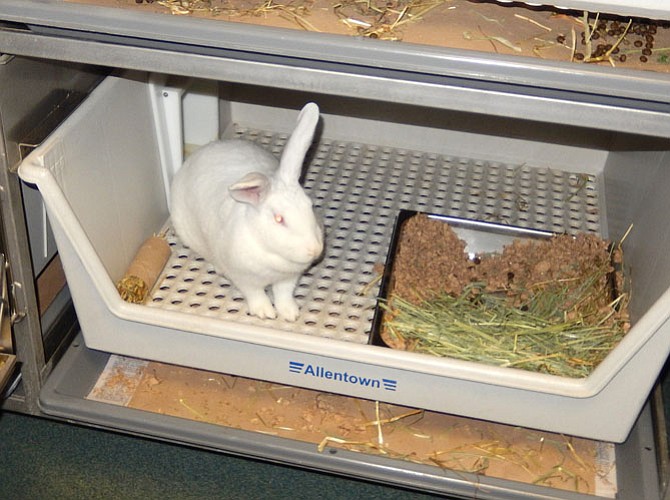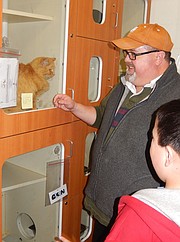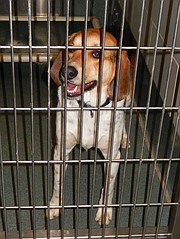A white bunny in the small-animal room. Photo by Bonnie Hobbs.
Details
The Fairfax County Animal Shelter is at 4500 West Ox Road and is open Tuesday through Friday, noon to 7 p.m., and Saturday, 10 a.m. to 5 p.m. For more information, go to http://www.fairfaxc….
Members of the Sully District Police Station’s Citizens Advisory Committee (CAC) got to tour Fairfax County’s Animal Shelter last Tuesday, March 11. They were divided into four groups and each learned about the shelter from a guide.
“In 2013, we became the largest jurisdiction in the United States with a placement rate above 90 percent,” said shelter spokeswoman Kristen Auerbach. “And we received a Compassion Award last year for avoiding euthanasia as much as possible.”
The shelter was built in 1975 and renovated in the mid-’80s. But as the county’s population grew, so did its pet population; and eventually, the 15,000-square-foot facility became cramped, crowded and outdated.
In November 2006, residents passed a public-safety bond that included $17 million for shelter renovation and expansion. Ground was broken in 2011 and work began, culminating in a May 2014 ribbon-cutting ceremony.
The shelter nearly doubled in size, to 29,000 square feet, and now boasts separate lobbies for adoption and animal receiving, new animal-holding spaces, a small-animal room, play yards, training rooms, a new air-ventilation system, more space for employees, a veterinary suite, visitation areas for adopters to meet pets, plus additional parking.
“We moved into the new facility in March of 2014,” said Auerbach. “We have about 150 foster families and 300 volunteers to walk the dogs. And we also work with wildlife rehabilitators.”
Passing by various staff offices with gates in the doorway, she said, “Employees either have their own pets or shelter pets with them in their offices. It’s good for the animals’ socialization.” She also noted that the building “doesn’t have an animal smell because it has six or seven, different ventilation systems and the air overturns 60 times an hour.”
This summer, said Auerbach, the shelter will offer animal-care camps for children. To learn more about them, see the county Park Authority’s booklet, “Parktakes.”
She said the shelter receives many more cats than dogs, and the best time to adopt cats is between June and October, when they’re plentiful at the shelter. She also pointed out the five, outdoor play yards where the dogs get exercise.
The visitors were able to pet some of the animals and especially enjoyed seeing the bunnies, gerbils and guinea pigs in the small-animal room. “Some people hoard guinea pigs and bunnies,” said Auerbach. “So we’ll often get 40 or 60 of them at a time.”
She also praised the shelter’s volunteers and said more are always welcome. “We had 25,000 volunteer hours last year,” said Auerbach. “Our volunteers are amazing.”


